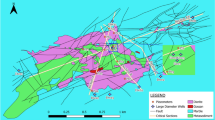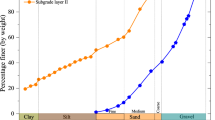Conclusions
-
1.
Hydraulic factors of the process of piping disintegration of gypsum-cemented sandstone, studied in connection with an evaluation of the seepage strength of the foundation of the Irganai dam on the Avarskoe Koisu River (Dagestan), were examined.
-
2.
A schematization of piping processes is presented, on which were based laboratory investigations that made it possible to reveal the effect of self-plugging of fractures in a rock mass having a framework of cemented grains and to establish criterion (based on the condition of no mechanical piping) values of the velocities and gradients of the head of water flowing through the fractures in the mass of such rocks.
-
3.
The results of the investigations can be used for a further, more detailed study of processes of hydrochemical decomposition of sedimentary rocks, as well as initial data when evaluating the piping resistance of the foundations of particular structures.
Similar content being viewed by others
Literature cited
E. M. Abashidze and M. N. Terletskaya, “Experimental investigations of seepage in fractured limestones and gypsinate shales,” in: Transactions of the Joint Conferences on Hydraulic Engineering [in Russian], No. 48 (1970).
G. K. Mamenko, The Kama Dam on the Kama River [in Russian], Énergiya, Moscow (1967).
D. P. Prochukhan, A. M. Lomtadze, and N. M. Natis, “Engineering-geological conditions of constructing the Kama hydroelectric station,” Sb. Lengidroproekta, No. 15 (1959).
V. P. Zverev, Hydrogeochemical Investigations of the Gypsum-Subsurface Water System [in Russian], Nauka, Moscow (1967).
N. N. Maslov and V. G. Naumenko, “Conditions of stability of dams on gypsinate strata,” in: Dissolution and Leaching of Rocks [in Russian], Gosstroiizdat, Moscow (1957).
V. G. Naumenko, “Laboratory investigations of the leachability of gypsum,” Tr. Leningr. Inzh. Stroit. Inst., No. 18 (1954).
A. E. Oradovskaya, Methods of Studying the Water Stability of Soft Gypsiferous Rocks [in Russian], Gosstroiizdat, Moscow (1961).
V. N. Zhilenkov, “Investigation of the piping resistance of gypsinate rock,” Izv. VNIIG im. B. E. Vedeneeva,165, (1983).
P. K. Weyl, Kinetics of Calcite Dissolution [Russian translation], Izd. Inostr. Lit., Moscow (1960).
N. G. Maksimovich and V. I. Sergeev, “Effect of chemical stabilization on the stability of gypsum in the foudnation of hydraulic structures,” Gidrotekh. Stroit., Simferopol (1958).
V. N. Kondrat'ev, Seepage and Mechanical Piping in Noncohesive Soils [in Russian], Krymizdat, Simferopol (1958).
V. N. Zhilenkov, “Hydraulic resistances to flow of water in fractured and granular media,” Izv. VNIIG im. B. E. Vedeneeva,168, (1983).
Design of Foundations of Hydraulic Structures. Aid to Building Code SNiP II-17-76 (II-13-83). Section 4: Foundation Seepage Calculations [in Russian], VNIIG im. B. E. Vedeneeva, Leningrad (1984).
Ts. E. Mirtskhulava, Fundamentals of the Physics and Mechanics of Channel Erosion [in Russian], Gidrometeoizdat, Leningrad (1989).
V. N. Zhilenkov, “Seepage strength of the transition of an earth-rock dam with a fractured rock foundation,” Izv. VNIIG im. B. E. Vedeneeva,104, (1974).
V. N. Zhilenkov, “Evaluation of the seepage strength of a fractured soft-rock mass,” Izv. VNIIG im. B. E. Vedeneeva,137. 94–99 (1980).
Guide to Methods of Determining the Seepage and Piping Properties of Rock Foundations. II.28-74/VNIIG [in Russian], Énergiya, Leningrad (1975).
A. V. Magomedova, “Consideration of the inhomogeneity of noncohesive soils when establishing allowable (noneroding) velocities of a water flow,” GrusNIIGiM, Tbilisi, No. 6 (1978).
A. N. James and A. R. R. Lupton, “Gypsum and anhydrite in foundations of hydraulic structures,” Geotechnique,28, No. 3, 249–272 (1978).
A. N. James and I. M. Kirpatrick, “Design of foundations of dumps containing soluble rocks and soils,” Quart. J. Eng. Geol.,13, No. 3 (1980).
Additional information
Translated from Gidrotekhnicheskoe Stroitel'stvo, No. 10, pp. 49–54, October, 1991.
Rights and permissions
About this article
Cite this article
Zhilenkov, V.E., Magomedov, K.G. Hydraulic factors of piping of fractured sandstone with gypsum cement. Hydrotechnical Construction 25, 652–661 (1991). https://doi.org/10.1007/BF01665654
Issue Date:
DOI: https://doi.org/10.1007/BF01665654




